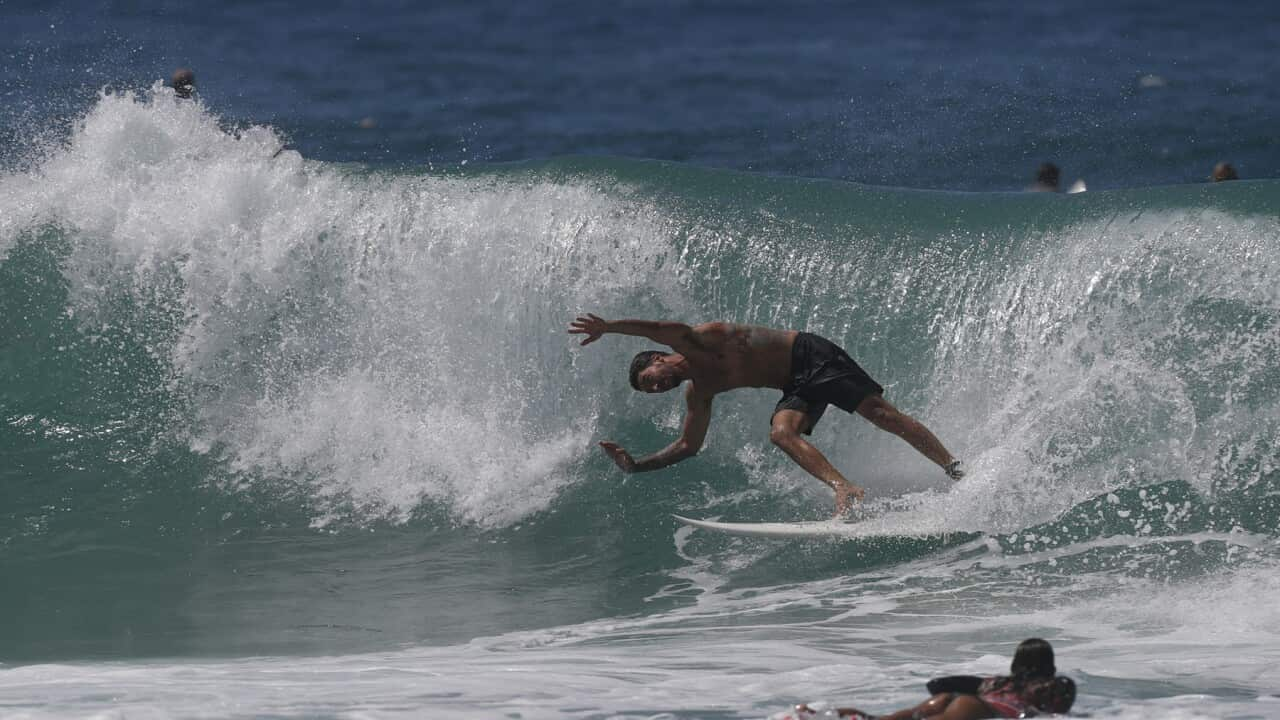English
Around 66 million years ago, dinosaurs had a very bad day.
A meteorite about 10 kilometres long hit the Earth, causing the death of 75 percent of the living species.
Since then, these creatures that dominated the planet for so long have become the subject of questions and answers about the history of our planet.
But the skeleton of one of these extinct dinosaurs, that is 145 million year old, will be up for sale in a private auction in France this month.
It is currently being exhibited in a castle on the outskirts of Paris ahead of the auction.
Pierre Vernet is a curious visitor who went to have a look.
“You need a bit of space, that's for sure. But still, it’s a real eye-catcher in a collection. I imagine that when you have a lot of money, it can be a way of having an exceptional piece that stands out from a painting or a sculpture.”
Valued at millions of dollars, its sale could set a new milestone in the booming market for fossils.
Dubbed “Vulcain,” the giant specimen is the largest dinosaur skeleton ever to come to auction.
It stretched 20.5 metres from tip to toe, weighed between 25 and 30 tonnes and lived in a herd.
Drouot Auctioner, Olivier Collin du Bocage says its a very rare piece.
"This is an exceptional piece for several reasons. Firstly, its size and state of preservation, with 80% original parts. Then, it's a dinosaur that was found in one piece. And it's also a dinosaur with parts that were previously unknown to science. We didn't know about the lower jaw. The little toes, we'd never found them. And then, it's called Vulcain, because you have this idea of fire with an attack that happened 145 million years ago with the vertebrae that kept the trace of an attack and that have been fused together. Hence this idea and its name of Vulcain or Vulcan."
The remains are believed to be those of an apatosaurus, extremely large herbivores that populated North America around 150 million years ago, in what scientists call the late Jurassic period.
This species is one of the most famous, thanks to the Steven Spielberg Hollywood movie, Jurassic Park.
Mr Bocage again.
"It's quite famous also because it is the first one to appear on Jurassic Park, It's (used) for toys for children. If you ask a child to draw a dinosaur, it will be this one. So it's quite impressive. Often you see a T-Rex, but now you have the biggest one with a small head but vegetarian."
But despite looking like the famous dinosaur, the sales catalogue says that the exact species is still unclear and that an official scientific identification will have to be made.
It was discovered in 2018 in Wyoming, but unearthing all the remains took 3 years, and after that they had to be taken for restoration.
Vulcain is expected to reach at least 11 million USD—16 million AUD—at the auction on November 16th.
The high value comes from what auctioneer Florent Barbarossa describes as a shift in the fossil market.
“Auctions have been going on for twenty years now. It was only in the media with the T-Rex that everyone knows, and there was a market where prices were always more or less the same. And then, over the last two years or so, the records just kept on coming. Eight of the top 10 auction sales have taken place in the last two years.”
The dinosaur could attract a variety of possible buyers struck by the appeal of having such a unique item in a private collection.
But the increasingly lucrative market frustrates some academic palaeontologists who feel the specimens belong in museums or research centres that can’t afford huge auction prices.
Visitor at the display in Paris, Cyril Fernandes shares his concerns about privatisation.
“It must be visible to as wide a public as possible. Privatising like that, for just one person, depends on what's being done afterwards, but I'm putting it into perspective. I’m thinking, well, if it's just for purely personal pleasure...”
Even so, Mr Bocage says the future buyer will grant scientists access to the dinosaur.
“The buyer will commit to allowing public access to this dinosaur in the future. That's why there's no controversy. Private funds have financed its research and restoration. The future buyer will give scientists access to this dinosaur.”
And with the fossil market booming, it seems like for now, there is no way back.
Mr Bocage says this type piece could become a new trend.
“It's a cultural good, it's also a financial good. It can be conceived in different ways. It's going to take me to Manila, to Dubai, to the United States, to meet a new demand, a new clientele who are no longer necessarily interested in the 18th century chest of drawers, but for whom a dinosaur is comparable to a Basquiat*."
*Jean Michel Basquiat was a world-renowned New York street-artist who died in 1988
Italian
Italiano
Circa 66 milioni di anni fa, vi fu un evento disastroso per i dinosauri.
Un meteorite lungo circa 10 chilometri colpì la Terra, causando la morte del 75% delle specie viventi.
Da quel giorno, queste creature che avevano dominato il pianeta per così tanto tempo sono diventate solo il soggetto di domande e risposte sulla storia del nostro pianeta.
Ma uno scheletro di uno di questi dinosauri estinti, che ha 145 milioni di anni, sarà messo in vendita in un'asta privata in Francia questo mese.
Al momento è esposto in un castello alla periferia di Parigi in vista dell'asta.
Pierre Vernet è un visitatore curioso che è andato a dare un'occhiata.
“You need a bit of space, that's for sure. But still, it’s a real eye-catcher in a collection. I imagine that when you have a lot of money, it can be a way of having an exceptional piece that stands out from a painting or a sculpture.”
Valutato milioni di dollari, la sua vendita potrebbe stabilire una nuova pietra miliare nel mercato dei fossili [che è] in forte espansione.
Soprannominato “Vulcain”, il gigantesco esemplare è il più grande scheletro di dinosauro mai messo all'asta.
L’animale era lungo 20,5 metri, pesava tra le 25 e le 30 tonnellate e viveva in branco.
Per il banditore dell’agenzia Drouot, Olivier Collin du Bocage, stiamo parlando di un pezzo molto raro.
"This is an exceptional piece for several reasons. Firstly, its size and state of preservation, with 80% original parts. Then, it's a dinosaur that was found in one piece. And it's also a dinosaur with parts that were previously unknown to science. We didn't know about the lower jaw. The little toes, we'd never found them. And then, it's called Vulcain, because you have this idea of fire with an attack that happened 145 million years ago with the vertebrae that kept the trace of an attack and that have been fused together. Hence this idea and its name of Vulcain or Vulcan."
Si ritiene che i resti siano quelli di un apatosauro, erbivoro di grandi dimensioni che popolava il Nord America circa 150 milioni di anni fa, in quello che gli scienziati chiamano il tardo Giurassico.
Questa specie è una delle più famose, grazie al film di Steven Spielberg, Jurassic Park.
Ecco ancora Bocage.
"It's quite famous also because it is the first one to appear on Jurassic Park, It's (used) for toys for children. If you ask a child to draw a dinosaur, it will be this one. So it's quite impressive. Often you see a T-Rex, but now you have the biggest one with a small head but vegetarian."
Ma nonostante l'aspetto faccia pensare al famoso dinosauro, nel catalogo di vendita si dice che la specie esatta non è ancora chiara e che dovrà essere effettuata un'identificazione scientifica ufficiale.
Vulcain è stato scoperto nel 2018 nel Wyoming, ma per portare alla luce tutti i resti ci sono voluti tre anni, dopodiché è stato necessario sottoporli a restauro.
Si prevede che Vulcain raggiungerà almeno 11 milioni di dollari americani (16 milioni di dollari australiani) all'asta del 16 novembre.
L'alto valore deriva da quello che il banditore Florent Barbarossa descrive come un cambiamento nel mercato dei fossili.
“Auctions have been going on for twenty years now. It was only in the media with the T-Rex that everyone knows, and there was a market where prices were always more or less the same. And then, over the last two years or so, the records just kept on coming. Eight of the top 10 auction sales have taken place in the last two years.”
Il dinosauro potrebbe attirare una serie di possibili acquirenti, affascinati dall'idea di avere un oggetto così unico in una collezione privata.
Ma il mercato sempre più lucrativo frustra alcuni paleontologi accademici secondo cui cui gli esemplari dovrebbero appartenere a musei o centri di ricerca che non possono permettersi prezzi d'asta elevati.
Cyril Fernandes, visitatore della mostra a Parigi, si dice preoccupato dalla privatizzazione.
“It must be visible to as wide a public as possible. Privatising like that, for just one person, depends on what's being done afterwards, but I'm putting it into perspective. I’m thinking, well, if it's just for purely personal pleasure...”
Nonostante questo, Bocage afferma che il futuro acquirente garantirà agli scienziati l'accesso al dinosauro.
“The buyer will commit to allowing public access to this dinosaur in the future. That's why there's no controversy. Private funds have financed its research and restoration. The future buyer will give scientists access to this dinosaur.”
E con il boom del mercato dei fossili, sembra che per ora non si possa tornare indietro.
Secondo Bocage, questo tipo di pezzo da collezione potrebbe diventare una nuova tendenza.
“It's a cultural good, it's also a financial good. It can be conceived in different ways. It's going to take me to Manila, to Dubai, to the United States, to meet a new demand, a new clientele who are no longer necessarily interested in the 18th century chest of drawers, but for whom a dinosaur is comparable to a Basquiat*."
*Jean Michel Basquiat, celebre street artist di New York morto nel 1988.
Report by SBS News












